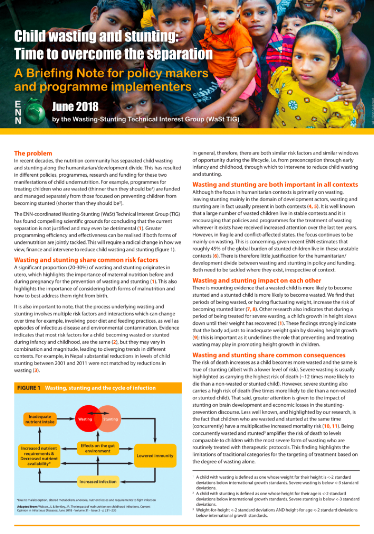Child wasting and stunting: Time to overcome the separation

A briefing note for policy-makers and programme implementers was released in June 2018 by the ENN-coordinated Wasting-Stunting Technical Interest Group (WaSt TIG). The brief, which is a culmination of their research and deliberations over the last four years, highlights that, in recent decades, the nutrition community has separated child wasting and stunting along the humanitarian/development divide. This has resulted in different policies, programmes, research and funding for these two manifestations of child undernutrition. For example, programmes treating wasting have been largely funded and managed separately from those focused on preventing stunting. In the brief, the WaSt TIG concludes that there are compelling scientific grounds for concluding that this separation is not justified and may even be detrimental. They group suggests that greater programming efficiency and effectiveness can be realised if both forms of undernutrition are jointly tackled. This will require a radical change in how we view, finance and intervene to reduce child wasting and stunting.
Recent research highlighted in the brief shows that wasting and stunting share common risk factors; are both important in most contexts; impact on each other; and share common consequences. There is also evidence that large numbers of children suffer from wasting and stunting at the same time; that boys are more vulnerable to both wasting and stunting; and that there are seasonal patterns in wasting and stunting that are related.
Implications of the findings
- We need to accelerate efforts to reduce wasting and stunting in all contexts where they are prevalent. This requires overcoming barriers which limit the focus in humanitarian response to the treatment of wasting and the prevention of stunting as the main focus of development efforts.
-
Because wasting and stunting share many of the same risk factors, we need greater integration of preventative activities and need to monitor and evaluate programme impacts on both manifestations of undernutrition and their crossover (concurrence).
-
The current low level of global coverage for the treatment of wasting is likely to be limiting the height growth of millions of infants and children by prolonging the period over which their growth slows down or halts completely; therefore scale-up of efficacious treatment should be priority – not just for mortality reduction but for stunting reduction as well.
-
Traditional categories for targeting therapeutic and supplementary programmes need to be challenged, based on a better understanding of mortality risk. Infants and children who are at most risk (including the concurrently wasted and stunted) should be prioritised for intervention. These children can be identified with existing methods; however more work is needed on the optimal ways to detect and treat them and on the resource and programme implications.
-
In view of the influence of season on wasting and stunting, timely interventions to prevent peaks are needed. Linking up services, whether social protection, health, nutrition or WASH, will better enable the multiple risk factors driving seasonal peaks in child undernutrition to be addressed simultaneously.
-
Given that maternal health and nutrition influence both weight and length at birth and subsequent child growth, we need to expand support to women not only for improved infant and child nutrition, but also to confer health and nutrition benefits directly on mothers.
-
In most contexts, boys are more wasted and stunted than girls. The reasons for this are unknown, but at a policy level this widespread finding indicates that common narratives around gender and heightened vulnerability of girls to malnutrition need to be revised.
The full policy brief is available here.
For more information please contact Tanya Khara.

